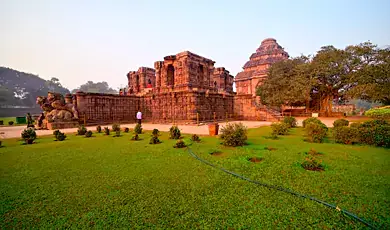
India's rich tapestry of history and civilization encloses numerous historic sites that offer a precise glance into its lively past. These India historical sites traverse centuries and recall the various impacts that have shaped the country, creating India a gem trove for narrative lovers and travellers alike. Among India's multiple iconic and historical places is the Taj Mahal; a sign of love is Mughal architecture. Emperor Shah Jahan built this beautiful white marble mausoleum in Agra to remember his cherished wife, Mumtaz Mahal, and one of the most seen historic locations. Another well-known chronological site in the country is the Red Fort in Delhi. This enormous red sandstone fort was the prior home of the Mughal emperors for over two centuries and now stands as a potent reminder of India’s rich Mughal past.
Moving towards South India, Hampi is an extraordinary ancient places in India that enchants tourists with its destructions of the Vijayanagara Empire. This UNESCO World Heritage place is an extensive open-air museum of chronological priority, with temples, palaces, and other designs that quote the magnificence of an ancient era. Hampi is one of the most significant historical places, offering a unique glimpse into the life and civilization of archaic India. In the western state of Rajasthan, the Amer Fort in Jaipur is a marvelous chronological landmark showcasing Rajput architecture's luxury. The fort’s decorated halls, comprehensive yards, and stunning sights make it one of the most popular historical sites of India.
Rajasthan, known as the motherland of kings, is sprinkled with diverse chronological sites, including the City Palace in Udaipur and the Mehrangarh Fort in Jodhpur, each depicting stories of fearlessness, amenity, and architectural majesty. These historic sites in India are more than just tourist attractions; they are symbols of the country’s rich and various artistic heritage. Analyzing these historic place of India enables one to trek through the pages of the past, encountering the majesty and heritage of India’s history and cultures.
| Sr. No. | List of Popular Historical Sites of India | More Information |
|---|---|---|
| 1 | Taj Mahal | |
| 2 | Hawa Mahal | View more |
| 3 | Khajuraho Temples | |
| 4 | Red Fort | |
| 5 | Qutub Minar | |
| 6 | Humayun Tomb | |
| 7 | Amer Fort | View more |
| 8 | Fatehpur Sikri | |
| 9 | Mehrangarh Fort | |
| 10 | Ajanta and Ellora Caves | |
| 11 | Mysore Palace | |
| 12 | Sanchi Stupa | |
| 13 | Gateway of India | |
| 14 | Konark Sun Temple | |
| 15 | Victoria Memorial | |
| 16 | Charminar | |
| 17 | Golconda Fort | |
| 18 | Mahabalipuram | |
| 19 | Jaisalmer Fort | |
| 20 | Rani ki Vav |






















